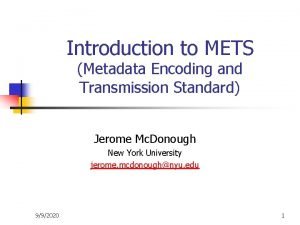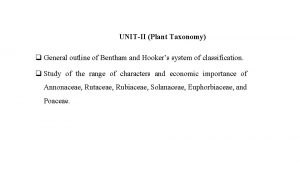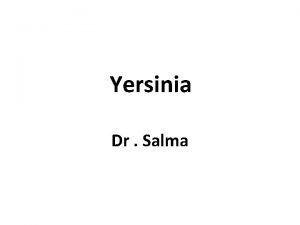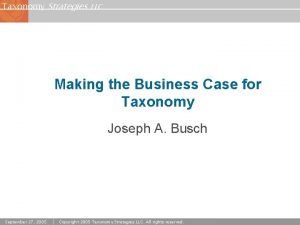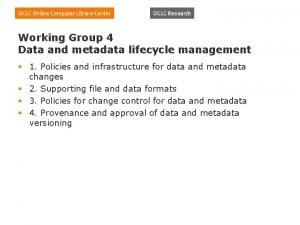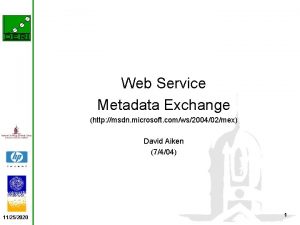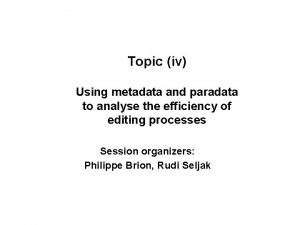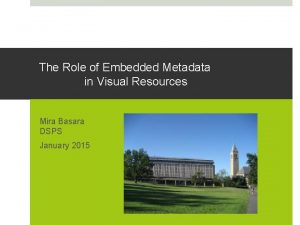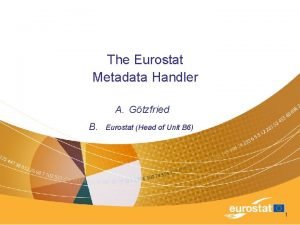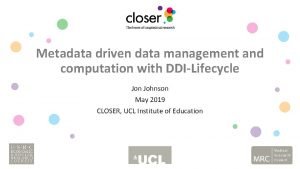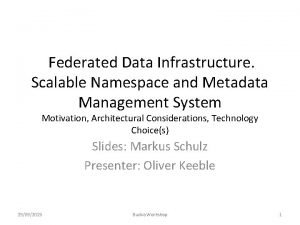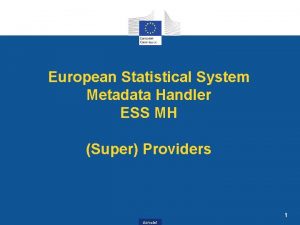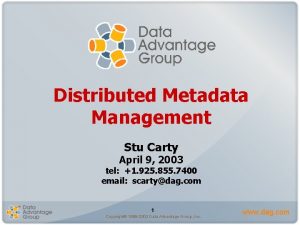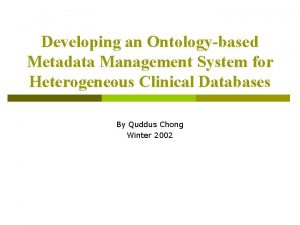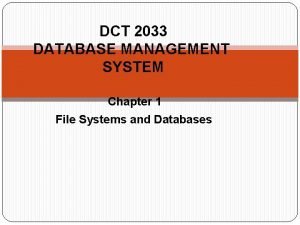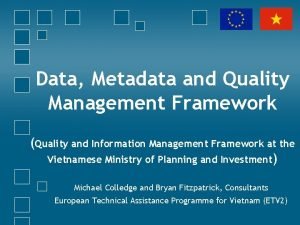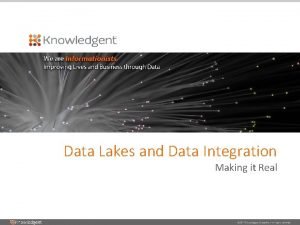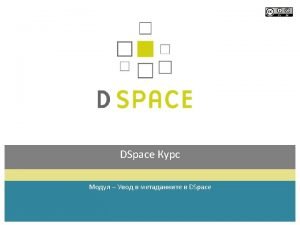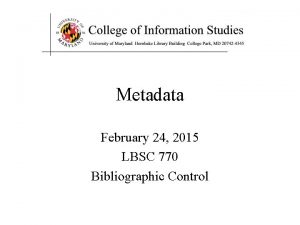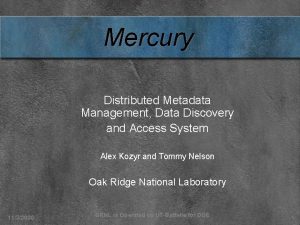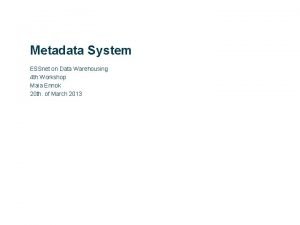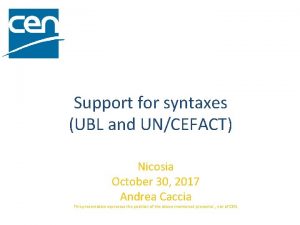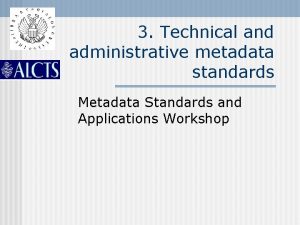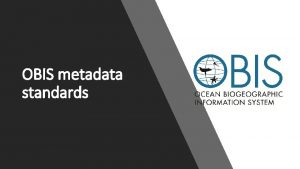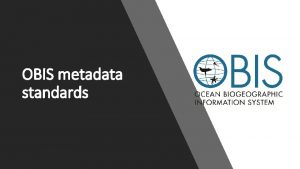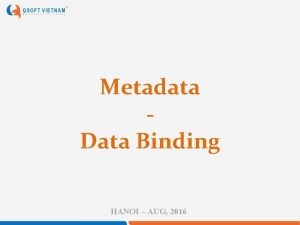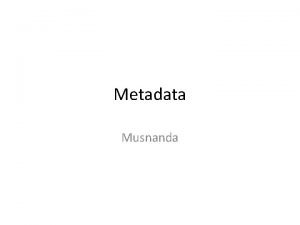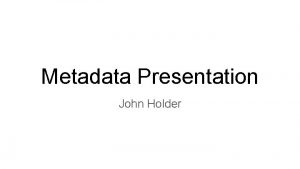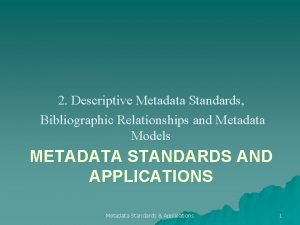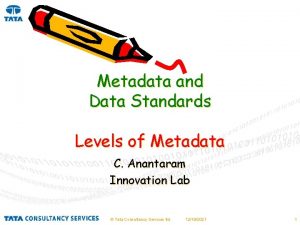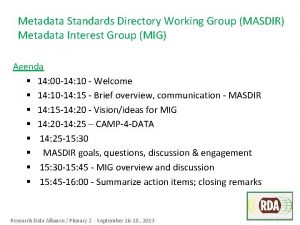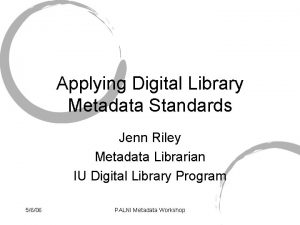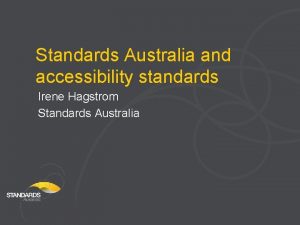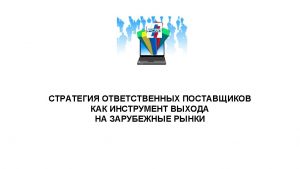Metadata Standards and Applications 4 Metadata Syntaxes and


























- Slides: 26

Metadata Standards and Applications 4. Metadata Syntaxes and Containers

Goals of Session u Understand the origin of and differences between the various syntaxes used for encoding information, including HTML, XML and RDF u Discover how container formats are used for managing digital resources and their metadata Metadata Standards & Applications 2

Overview of Syntaxes u. HTML, XHTML: Hypertext Markup Language; e. Xtensible Hypertext Markup Language u. XML: Extensible Markup Language u. RDF: Resource Description Framework Metadata Standards & Applications 3

HTML u. Hyper. Text Markup Language u. HTML 4 is the current standard u. HTML is an SGML (Standard Generalized Markup Language) application conforming to International Standard ISO 8879 u. Widely regarded as the standard publishing language of the World Wide Web u. HTML addressed the problem of SGML complexity by specifying a small set of structural and semantic tags suitable for authoring relatively simple documents Metadata Standards & Applications 4

XHTML u XML-ized version of HTML 4. 0, tightens up HTML to match XML syntax – Requires ending tags, quoted attributes, lower case, etc. , to conform to XML requirements u XHTML is a W 3 C specification, redefining HTML as an XML implementation, rather than an SGML implementation u Imposes requirements that are intended to lead to more well-formed, valid XML, easier for browsers to handle Metadata Standards & Applications 5

An XHTML <link rel="schema. DC" href="http: //purl. org/dc/elements/1. 1/" /> Example <link rel="schema. DCTERMS" href="http: //purl. org/dc/terms/" /> <meta name="DC. title" content="Using Dublin Core" /> <meta name="DC. creator" content="Diane Hillmann" /> <meta name="DC. subject" content="documents; Bibliography; Model; meta; Glossary; mark; matching; refinements; XHTML; Controlled; Qualifiers; Hillmann; mixing; encoding; Diane; Issues; Appendix; elements; Simple; Special; element; trademark/service; DCMI; Dublin; pages; Section; Resource; Grammatical; Qualified; XML; Using; Principles; Documents; licensing; OCLC; formal; Usageguide; Roles; Implementing; Contents; Guidelines; Expressing; Table; Syntax; Content; Element; DC. dot; Home; document; Metadata; RDF/XML; Website; metadata; privacy; schemes; liability; profiles; Elements; Copyright; Localization; schemas; HTML/XHTML; Core; Guide; registry; Research; contact; Scope; Projects; languages; Maintenance; Application; available; Internationalization; HTML; Recommended; link; Purpose; Abstract; Ask. DCMI; Vocabularies; software; Storage; Introduction" /> <meta name="DC. description" content="This document is intended as an entry point for users of Dublin Core. For non-specialists, it will assist them in creating simple descriptive records for information resources (for example, electronic documents). Specialists may find the document a useful point of reference to the documentation of Dublin Core, as it changes and grows. " /> <meta name="DC. publisher" content="Dublin Core Metadata Initiative" /> <meta name="DC. type" scheme="DCTERMS. DCMIType" content="Text" /> <meta name="DC. format" content="text/html" /> <meta name="DC. format" content="31250 bytes" /> <meta name="DC. identifier" scheme="DCTERMS. URI" content="http: //dublincore. org/documents/usageguide/" /> Metadata Standards & Applications 6

XML u. Extensible Markup Language u. A ‘metamarkup’ language: has no fixed tags or elements u. Strict grammar imposes structure designed to be read by machines u. Two levels of conformance: – well-formed--conforms to general grammar rules – valid--conforms to particular XML schema or DTD (document type definition) Metadata Standards & Applications 7

XML is the lingua franca of the Web u u u Web pages increasingly use at least XHTML Business use for data exchange/messaging Family of technologies can be leveraged – XML Schema, XSLT, XPath, and Xquery u Software tools widely available (many open source) – Storage, editing, parsing, validating, transforming and publishing XML u u Microsoft Office 2003 supports XML as document format (Word. ML and Excel. ML) Web 2. 0 applications are based on XML Metadata Standards & Applications 8

An XML Schema May Define: u What elements may be used u Of which types u Any attributes u In which order u Optional or compulsory u Repeatability u Sub-elements u Logic Metadata Standards & Applications 9

Anatomy of an XML Record u. XML declaration--prepares the processor to work with the document u. Namespaces (uses xmlns: prefix and a URI to attach a prefix to each element and attribute) – Distinguishes between elements and attributes from different vocabularies that might share a name (but not necessarily a definition) using association with URIs – Groups all related elements from an application so software can deal with them – The URIs are the standardized bit, not the prefix, and they don’t necessarily lead anywhere useful, even if they look like URLs Metadata Standards & Applications 10

XML Anatomy Lesson Name Attribute Content <marc: subfield code="a">Metadata in practice /</marc: subfield> Start Tag End Tag Metadata Standards & Applications 11

Namespace Anatomy Lesson XML Namespace Identifier xmlns: dc=”http: //purl. org/dc/elements/1. 1/” Namespace Prefix Metadata Standards & Applications 12

RDF u. Resource Description Framework--A language for describing resources for the web u. Structure based on “triples” u. Focused on exchange of information between different kinds of organizations and usages u. Considered an essential part of the Semantic Web u. Can be expressed using XML Metadata Standards & Applications 13

Some RDF Concepts u. A Resource is anything that you want to describe; it’s most often identified with a URI, such as: http: //dublincore. org/documents/usageguide/ u. A Class is a category; it is a set that comprises individuals u. A Property is a Resource that has a name, such as "creator" or "homepage" u. A Property value is the value of a Property, such as ”George Washington" or "http: //www. w 3 schools. com/" (note that a property value can be another resource) Metadata Standards & Applications 14

RDF Statements u The combination of a Resource, a Property, and a Property value forms a Statement (includes a subject, predicate and object) u An example Statement: "The editor of http: //dublincore. org/documents/usageguide/ is Diane Hillmann" – The subject of the statement above is: http: //dublincore. org/documents/usageguide/ – – The predicate is: editor The object is: Diane Hillmann Metadata Standards & Applications 15

RDF and OWL RDF does not have the language to specify all relationships u Web Ontology Language (OWL) can specify richer relationships, such as equivalence, inverse, unique u RDF and OWL may be used together u Resource Description Framework Schema (RDFS): a syntax for expressing relationships between elements u Metadata Standards & Applications 16

An XML/RDF Example <rdf: RDF Note xmlns: rdf="http: //www. w 3. org/1999/02/22 -rdf-syntax-ns#" rdf: about xmlns: dc="http: //purl. org/dc/elements/1. 1/"> <rdf: Description rdf: about="http: //www. dlib. org"> <dc: title>D-Lib Program - Research in Digital Libraries</dc: title> <dc: description>The D-Lib program supports the community of people with research interests in digital libraries and electronic publishing. </dc: description> <dc: publisher>Corporation For National Research Initiatives</dc: publisher> <dc: date>1995 -01 -07</dc: date> <dc: subject> Note <rdf: Bag> unordered <rdf: li>Research; statistical methods</rdf: li> list <rdf: li>Education, research, related topics</rdf: li> <rdf: li>Library use Studies</rdf: li> </rdf: Bag> </dc: subject> <dc: type>World Wide Web Home Page</dc: type> <dc: format>text/html</dc: format> <dc: language>en</dc: language> </rdf: Description> </rdf: RDF> Metadata Standards & Applications 17

Overview of Container Formats A container format is used to package together all forms of metadata and digital content u Use of a container is compatible with, and an implementation of, the OAIS information package concept u METS: packages metadata with objects or links to objects and defines structural relationships u MPEG 21 DID: represents digital objects u Metadata Standards & Applications 18

METS u Metadata Encoding & Transmission Standard u Developed by the Digital Library Federation, maintained by the Library of Congress u “. . . an XML document format for encoding metadata necessary for both management of digital library objects within a repository and exchange of such objects between repositories (or between repositories and their users). ” u METS is open source and developed by open discussion u Cultural heritage community is the main audience Metadata Standards & Applications 19

METS Usage u To package metadata with digital object in XML syntax u For retrieving, storing, preserving, serving resource u For interchange of digital objects with their metadata u As an information package in a digital repository (may be a unit of storage or a transmission format) Metadata Standards & Applications 20

METS Sections u Defined in METS schema for navigation & browsing – – 1. Header (XML Namespaces) 2. File inventory 3. Structural Map & Links 4. Descriptive Metadata (not part of METS but uses an externally developed descriptive metadata standard, e. g. DC, MODS) – 5. Administrative Metadata (points to external schemas): u 1. Technical, Source u 2. Digital Provenance u 3. Rights Metadata Standards & Applications 21

Metadata Standards & Applications 22

METS Extension Schemas u “Wrappers” or “sockets” where elements from other schemas can be plugged in – Uses the XML Schema facility for combining vocabularies from different Namespaces u Endorsed extension schemas: – Descriptive: DC, MODS, MARCXML – Technical metadata: MIX (image); text. MD (text) – Preservation related: PREMIS Metadata Standards & Applications 23

MPEG-21 Digital Item Declaration (DID) u u u ISO/IEC 21000 -2: Digital Item Declaration – An alternative to represent Digital Objects – Supported by some repositories, e. g. , a. DORe, DSpace, Fedora Model that represents compound objects (recursive “item”) MPEG DID is an ISO standard and has industry support, but it is often implemented in a proprietary environment and the standards development is closed (as is ISO in general) Metadata Standards & Applications 24

MPEG 21 Abstract Model Metadata Standards & Applications 25

An Exercise u. Encode a simple resource in both DC and MARC using XML u. Use the template forms provided Metadata Standards & Applications 26
 Customer service standards table
Customer service standards table Metadata encoding and transmission standard
Metadata encoding and transmission standard Annona squamosa floral formula
Annona squamosa floral formula Metadata and taxonomy
Metadata and taxonomy Bubonic plague
Bubonic plague Metadata taxonomy
Metadata taxonomy Metadata lifecycle
Metadata lifecycle Http msdn
Http msdn Paradata vs metadata
Paradata vs metadata What is embedded metadata
What is embedded metadata Fido metadata service
Fido metadata service Metadata handler
Metadata handler What is metadata in database
What is metadata in database Api driven ddi
Api driven ddi Federated metadata management
Federated metadata management Metadata handler
Metadata handler Source:systems, process
Source:systems, process Distributed metadata management
Distributed metadata management Clinical metadata management tool
Clinical metadata management tool Dbms manages the interaction between
Dbms manages the interaction between Metadata management framework
Metadata management framework Eap data lake
Eap data lake Metadata
Metadata Metadata management wiki
Metadata management wiki Metadata
Metadata Distributed metadata management
Distributed metadata management Metadata layer data warehouse
Metadata layer data warehouse

